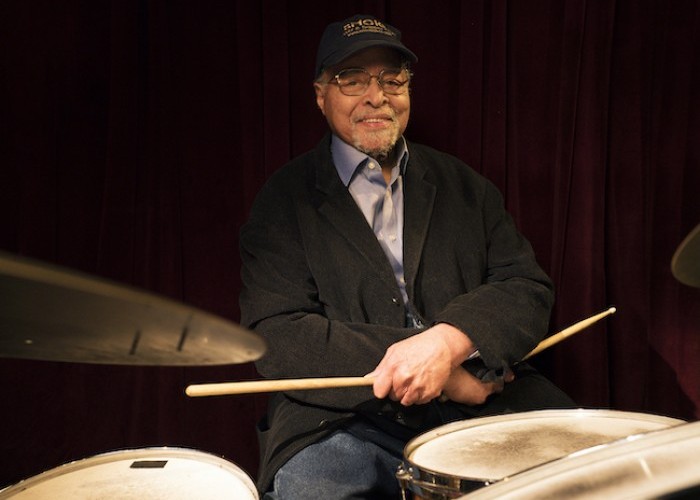Oct 28, 2025 10:47 AM
In Memoriam: Jack DeJohnette, 1942–2025
Jack DeJohnette, a bold and resourceful drummer and NEA Jazz Master who forged a unique vocabulary on the kit over his…

Jimmy Cobb, who turned 90 in January, recently issued a new quartet album, This I Dig Of You.
(Photo: Jimmy Katz)Achieving maximum impact with minimal fuss has been Jimmy Cobb’s M.O. on the drum kit throughout his career, not least on his latest leader album, This I Dig Of You (Smoke Sessions), recorded two weeks after his 90th birthday. It’s another session for which Cobb has retained the services of guitarist Peter Bernstein and bassist John Webber, both frequent bandstand partners since the cusp of the ’90s, and his first with pianist Harold Mabern.
The 10-tune date includes standards, Great American Songbook ballads, less traveled torch songs, Mabern’s modal “Edward Lee” and an original Bernstein blues. It’s a swinging affair, propelled by Cobb’s atomic-clock steady time feel and pristine touch on all his drum-kit components, not least the centered, resonant ride cymbal heard on iconic Miles Davis dates like Kind Of Blue and In Person: Friday Night At The Blackhawk, and classic sessions with Wes Montgomery, Sarah Vaughan, Cannonball Adderley and Dinah Washington.
“I developed it from not having something else,” Cobb remarked of his ride-cymbal concept in June, during a week at the Village Vanguard with the This I Dig Of You band. “Once, on a gig with Dizzy Gillespie, I was playing a coordination thing out of Jim Chapin’s book with figures he’d heard guys play without the bass drum being in 4, as guys had done in the big bands, so that everyone could hear the beat. Dizzy probably was used to hearing his guys play that way, and he came over and put his ear down by the bass drum. I told him, ‘Well, Birks, I don’t have a big 4/4 like that.’ I had to have the beat somewhere, so I concentrated on making it heard on the cymbal. I always liked the way Kenny Clarke played the cymbal—nice and quiet, but definite and killing—and I got some stuff from him.”
Bernstein got his first taste of the Cobb effect circa 1988, when he took the drummer’s Rhythmic Development class at Manhattan’s New School. “Jimmy just called tunes, which we still do,” Bernstein said about the informal sessions. “He didn’t say much about doing this or that. It was the feeling, the lift he provided. I’d never felt such a big or buoyant beat—that smooth ride, the little phrases and the way he resolved them, the accents that pushed the music and moved it forward.”
Cobb continues to impart his “deeds, not words” philosophy to young drummers seeking to unlock the key to his magical ride cymbal. “I tell them the same thing I had to learn,” he said. “Keep a good beat, and don’t work too hard with it—just keep it straight, so everybody likes it.
“I don’t believe in a whole lot of extra motion. I just try to make the guys feel good. That’s all it is. It’s a science, but it’s also not. The part that’s science is to keep the beat going. The art is to make it so we can all enjoy ourselves.” DB

Jack DeJohnette boasted a musical resume that was as long as it was fearsome.
Oct 28, 2025 10:47 AM
Jack DeJohnette, a bold and resourceful drummer and NEA Jazz Master who forged a unique vocabulary on the kit over his…

D’Angelo achieved commercial and critical success experimenting with a fusion of jazz, funk, soul, R&B and hip-hop.
Oct 14, 2025 1:47 PM
D’Angelo, a Grammy-winning R&B and neo-soul singer, guitarist and pianist who exerted a profound influence on 21st…

Kandace Springs channeled Shirley Horn’s deliberate phrasing and sublime self-accompaniment during her set at this year’s Pittsburgh International Jazz Festival.
Sep 30, 2025 12:28 PM
Janis Burley, the Pittsburgh International Jazz Festival’s founder and artistic director, did not, as might be…

Jim McNeely’s singular body of work had a profound and lasting influence on many of today’s top jazz composers in the U.S. and in Europe.
Oct 7, 2025 3:40 PM
Pianist Jim McNeely, one of the most distinguished large ensemble jazz composers of his generation, died Sept. 26 at…

Drummond was cherished by generations of mainstream jazz listeners and bandleaders for his authoritative tonal presence, a defining quality of his style most apparent when he played his instrument unamplified.
Nov 4, 2025 11:39 AM
Ray Drummond, a first-call bassist who appeared on hundreds of albums as a sideman for some of the top names in jazz…